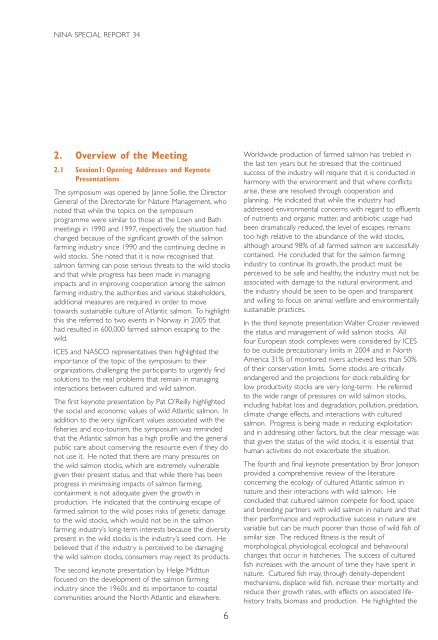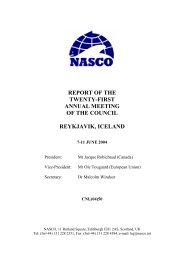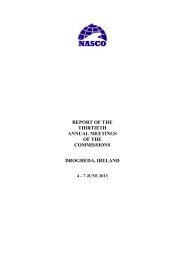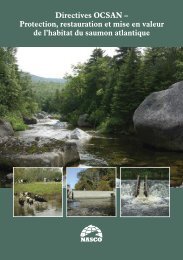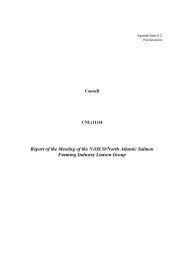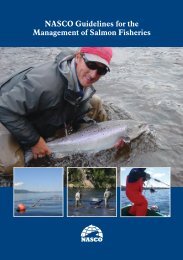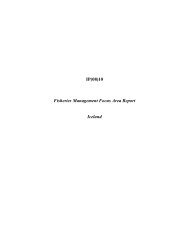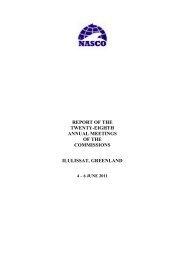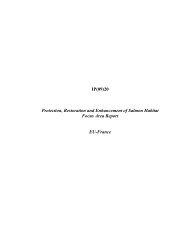Report of the 2005 ICES/NASCO Symposium on Interactions ...
Report of the 2005 ICES/NASCO Symposium on Interactions ...
Report of the 2005 ICES/NASCO Symposium on Interactions ...
Create successful ePaper yourself
Turn your PDF publications into a flip-book with our unique Google optimized e-Paper software.
NINA SPECIAL REPORT 34<br />
2. Overview <str<strong>on</strong>g>of</str<strong>on</strong>g> <str<strong>on</strong>g>the</str<strong>on</strong>g> Meeting<br />
2.1 Sessi<strong>on</strong>1: Opening Addresses and Keynote<br />
Presentati<strong>on</strong>s<br />
The symposium was opened by Janne Sollie, <str<strong>on</strong>g>the</str<strong>on</strong>g> Director<br />
General <str<strong>on</strong>g>of</str<strong>on</strong>g> <str<strong>on</strong>g>the</str<strong>on</strong>g> Directorate for Nature Management, who<br />
noted that while <str<strong>on</strong>g>the</str<strong>on</strong>g> topics <strong>on</strong> <str<strong>on</strong>g>the</str<strong>on</strong>g> symposium<br />
programme were similar to those at <str<strong>on</strong>g>the</str<strong>on</strong>g> Loen and Bath<br />
meetings in 1990 and 1997, respectively, <str<strong>on</strong>g>the</str<strong>on</strong>g> situati<strong>on</strong> had<br />
changed because <str<strong>on</strong>g>of</str<strong>on</strong>g> <str<strong>on</strong>g>the</str<strong>on</strong>g> significant growth <str<strong>on</strong>g>of</str<strong>on</strong>g> <str<strong>on</strong>g>the</str<strong>on</strong>g> salm<strong>on</strong><br />
farming industry since 1990 and <str<strong>on</strong>g>the</str<strong>on</strong>g> c<strong>on</strong>tinuing decline in<br />
wild stocks. She noted that it is now recognised that<br />
salm<strong>on</strong> farming can pose serious threats to <str<strong>on</strong>g>the</str<strong>on</strong>g> wild stocks<br />
and that while progress has been made in managing<br />
impacts and in improving cooperati<strong>on</strong> am<strong>on</strong>g <str<strong>on</strong>g>the</str<strong>on</strong>g> salm<strong>on</strong><br />
farming industry, <str<strong>on</strong>g>the</str<strong>on</strong>g> authorities and various stakeholders,<br />
additi<strong>on</strong>al measures are required in order to move<br />
towards sustainable culture <str<strong>on</strong>g>of</str<strong>on</strong>g> Atlantic salm<strong>on</strong>. To highlight<br />
this she referred to two events in Norway in <str<strong>on</strong>g>2005</str<strong>on</strong>g> that<br />
had resulted in 600,000 farmed salm<strong>on</strong> escaping to <str<strong>on</strong>g>the</str<strong>on</strong>g><br />
wild.<br />
<str<strong>on</strong>g>ICES</str<strong>on</strong>g> and <str<strong>on</strong>g>NASCO</str<strong>on</strong>g> representatives <str<strong>on</strong>g>the</str<strong>on</strong>g>n highlighted <str<strong>on</strong>g>the</str<strong>on</strong>g><br />
importance <str<strong>on</strong>g>of</str<strong>on</strong>g> <str<strong>on</strong>g>the</str<strong>on</strong>g> topic <str<strong>on</strong>g>of</str<strong>on</strong>g> <str<strong>on</strong>g>the</str<strong>on</strong>g> symposium to <str<strong>on</strong>g>the</str<strong>on</strong>g>ir<br />
organizati<strong>on</strong>s, challenging <str<strong>on</strong>g>the</str<strong>on</strong>g> participants to urgently find<br />
soluti<strong>on</strong>s to <str<strong>on</strong>g>the</str<strong>on</strong>g> real problems that remain in managing<br />
interacti<strong>on</strong>s between cultured and wild salm<strong>on</strong>.<br />
The first keynote presentati<strong>on</strong> by Pat O’Reilly highlighted<br />
<str<strong>on</strong>g>the</str<strong>on</strong>g> social and ec<strong>on</strong>omic values <str<strong>on</strong>g>of</str<strong>on</strong>g> wild Atlantic salm<strong>on</strong>. In<br />
additi<strong>on</strong> to <str<strong>on</strong>g>the</str<strong>on</strong>g> very significant values associated with <str<strong>on</strong>g>the</str<strong>on</strong>g><br />
fisheries and eco-tourism, <str<strong>on</strong>g>the</str<strong>on</strong>g> symposium was reminded<br />
that <str<strong>on</strong>g>the</str<strong>on</strong>g> Atlantic salm<strong>on</strong> has a high pr<str<strong>on</strong>g>of</str<strong>on</strong>g>ile and <str<strong>on</strong>g>the</str<strong>on</strong>g> general<br />
public care about c<strong>on</strong>serving <str<strong>on</strong>g>the</str<strong>on</strong>g> resource even if <str<strong>on</strong>g>the</str<strong>on</strong>g>y do<br />
not use it. He noted that <str<strong>on</strong>g>the</str<strong>on</strong>g>re are many pressures <strong>on</strong><br />
<str<strong>on</strong>g>the</str<strong>on</strong>g> wild salm<strong>on</strong> stocks, which are extremely vulnerable<br />
given <str<strong>on</strong>g>the</str<strong>on</strong>g>ir present status, and that while <str<strong>on</strong>g>the</str<strong>on</strong>g>re has been<br />
progress in minimising impacts <str<strong>on</strong>g>of</str<strong>on</strong>g> salm<strong>on</strong> farming,<br />
c<strong>on</strong>tainment is not adequate given <str<strong>on</strong>g>the</str<strong>on</strong>g> growth in<br />
producti<strong>on</strong>. He indicated that <str<strong>on</strong>g>the</str<strong>on</strong>g> c<strong>on</strong>tinuing escape <str<strong>on</strong>g>of</str<strong>on</strong>g><br />
farmed salm<strong>on</strong> to <str<strong>on</strong>g>the</str<strong>on</strong>g> wild poses risks <str<strong>on</strong>g>of</str<strong>on</strong>g> genetic damage<br />
to <str<strong>on</strong>g>the</str<strong>on</strong>g> wild stocks, which would not be in <str<strong>on</strong>g>the</str<strong>on</strong>g> salm<strong>on</strong><br />
farming industry’s l<strong>on</strong>g-term interests because <str<strong>on</strong>g>the</str<strong>on</strong>g> diversity<br />
present in <str<strong>on</strong>g>the</str<strong>on</strong>g> wild stocks is <str<strong>on</strong>g>the</str<strong>on</strong>g> industry’s seed corn. He<br />
believed that if <str<strong>on</strong>g>the</str<strong>on</strong>g> industry is perceived to be damaging<br />
<str<strong>on</strong>g>the</str<strong>on</strong>g> wild salm<strong>on</strong> stocks, c<strong>on</strong>sumers may reject its products.<br />
The sec<strong>on</strong>d keynote presentati<strong>on</strong> by Helge Midttun<br />
focused <strong>on</strong> <str<strong>on</strong>g>the</str<strong>on</strong>g> development <str<strong>on</strong>g>of</str<strong>on</strong>g> <str<strong>on</strong>g>the</str<strong>on</strong>g> salm<strong>on</strong> farming<br />
industry since <str<strong>on</strong>g>the</str<strong>on</strong>g> 1960s and its importance to coastal<br />
communities around <str<strong>on</strong>g>the</str<strong>on</strong>g> North Atlantic and elsewhere.<br />
6<br />
Worldwide producti<strong>on</strong> <str<strong>on</strong>g>of</str<strong>on</strong>g> farmed salm<strong>on</strong> has trebled in<br />
<str<strong>on</strong>g>the</str<strong>on</strong>g> last ten years but he stressed that <str<strong>on</strong>g>the</str<strong>on</strong>g> c<strong>on</strong>tinued<br />
success <str<strong>on</strong>g>of</str<strong>on</strong>g> <str<strong>on</strong>g>the</str<strong>on</strong>g> industry will require that it is c<strong>on</strong>ducted in<br />
harm<strong>on</strong>y with <str<strong>on</strong>g>the</str<strong>on</strong>g> envir<strong>on</strong>ment and that where c<strong>on</strong>flicts<br />
arise, <str<strong>on</strong>g>the</str<strong>on</strong>g>se are resolved through cooperati<strong>on</strong> and<br />
planning. He indicated that while <str<strong>on</strong>g>the</str<strong>on</strong>g> industry had<br />
addressed envir<strong>on</strong>mental c<strong>on</strong>cerns with regard to effluents<br />
<str<strong>on</strong>g>of</str<strong>on</strong>g> nutrients and organic matter, and antibiotic usage had<br />
been dramatically reduced, <str<strong>on</strong>g>the</str<strong>on</strong>g> level <str<strong>on</strong>g>of</str<strong>on</strong>g> escapes remains<br />
too high relative to <str<strong>on</strong>g>the</str<strong>on</strong>g> abundance <str<strong>on</strong>g>of</str<strong>on</strong>g> <str<strong>on</strong>g>the</str<strong>on</strong>g> wild stocks,<br />
although around 98% <str<strong>on</strong>g>of</str<strong>on</strong>g> all farmed salm<strong>on</strong> are successfully<br />
c<strong>on</strong>tained. He c<strong>on</strong>cluded that for <str<strong>on</strong>g>the</str<strong>on</strong>g> salm<strong>on</strong> farming<br />
industry to c<strong>on</strong>tinue its growth, <str<strong>on</strong>g>the</str<strong>on</strong>g> product must be<br />
perceived to be safe and healthy, <str<strong>on</strong>g>the</str<strong>on</strong>g> industry must not be<br />
associated with damage to <str<strong>on</strong>g>the</str<strong>on</strong>g> natural envir<strong>on</strong>ment, and<br />
<str<strong>on</strong>g>the</str<strong>on</strong>g> industry should be seen to be open and transparent<br />
and willing to focus <strong>on</strong> animal welfare and envir<strong>on</strong>mentally<br />
sustainable practices.<br />
In <str<strong>on</strong>g>the</str<strong>on</strong>g> third keynote presentati<strong>on</strong> Walter Crozier reviewed<br />
<str<strong>on</strong>g>the</str<strong>on</strong>g> status and management <str<strong>on</strong>g>of</str<strong>on</strong>g> wild salm<strong>on</strong> stocks. All<br />
four European stock complexes were c<strong>on</strong>sidered by <str<strong>on</strong>g>ICES</str<strong>on</strong>g><br />
to be outside precauti<strong>on</strong>ary limits in 2004 and in North<br />
America 31% <str<strong>on</strong>g>of</str<strong>on</strong>g> m<strong>on</strong>itored rivers achieved less than 50%<br />
<str<strong>on</strong>g>of</str<strong>on</strong>g> <str<strong>on</strong>g>the</str<strong>on</strong>g>ir c<strong>on</strong>servati<strong>on</strong> limits. Some stocks are critically<br />
endangered and <str<strong>on</strong>g>the</str<strong>on</strong>g> projecti<strong>on</strong>s for stock rebuilding for<br />
low productivity stocks are very l<strong>on</strong>g-term. He referred<br />
to <str<strong>on</strong>g>the</str<strong>on</strong>g> wide range <str<strong>on</strong>g>of</str<strong>on</strong>g> pressures <strong>on</strong> wild salm<strong>on</strong> stocks,<br />
including habitat loss and degradati<strong>on</strong>, polluti<strong>on</strong>, predati<strong>on</strong>,<br />
climate change effects, and interacti<strong>on</strong>s with cultured<br />
salm<strong>on</strong>. Progress is being made in reducing exploitati<strong>on</strong><br />
and in addressing o<str<strong>on</strong>g>the</str<strong>on</strong>g>r factors, but <str<strong>on</strong>g>the</str<strong>on</strong>g> clear message was<br />
that given <str<strong>on</strong>g>the</str<strong>on</strong>g> status <str<strong>on</strong>g>of</str<strong>on</strong>g> <str<strong>on</strong>g>the</str<strong>on</strong>g> wild stocks, it is essential that<br />
human activities do not exacerbate <str<strong>on</strong>g>the</str<strong>on</strong>g> situati<strong>on</strong>.<br />
The fourth and final keynote presentati<strong>on</strong> by Bror J<strong>on</strong>ss<strong>on</strong><br />
provided a comprehensive review <str<strong>on</strong>g>of</str<strong>on</strong>g> <str<strong>on</strong>g>the</str<strong>on</strong>g> literature<br />
c<strong>on</strong>cerning <str<strong>on</strong>g>the</str<strong>on</strong>g> ecology <str<strong>on</strong>g>of</str<strong>on</strong>g> cultured Atlantic salm<strong>on</strong> in<br />
nature and <str<strong>on</strong>g>the</str<strong>on</strong>g>ir interacti<strong>on</strong>s with wild salm<strong>on</strong>. He<br />
c<strong>on</strong>cluded that cultured salm<strong>on</strong> compete for food, space<br />
and breeding partners with wild salm<strong>on</strong> in nature and that<br />
<str<strong>on</strong>g>the</str<strong>on</strong>g>ir performance and reproductive success in nature are<br />
variable but can be much poorer than those <str<strong>on</strong>g>of</str<strong>on</strong>g> wild fish <str<strong>on</strong>g>of</str<strong>on</strong>g><br />
similar size. The reduced fitness is <str<strong>on</strong>g>the</str<strong>on</strong>g> result <str<strong>on</strong>g>of</str<strong>on</strong>g><br />
morphological, physiological, ecological and behavioural<br />
changes that occur in hatcheries. The success <str<strong>on</strong>g>of</str<strong>on</strong>g> cultured<br />
fish increases with <str<strong>on</strong>g>the</str<strong>on</strong>g> amount <str<strong>on</strong>g>of</str<strong>on</strong>g> time <str<strong>on</strong>g>the</str<strong>on</strong>g>y have spent in<br />
nature. Cultured fish may, through density-dependent<br />
mechanisms, displace wild fish, increase <str<strong>on</strong>g>the</str<strong>on</strong>g>ir mortality and<br />
reduce <str<strong>on</strong>g>the</str<strong>on</strong>g>ir growth rates, with effects <strong>on</strong> associated lifehistory<br />
traits, biomass and producti<strong>on</strong>. He highlighted <str<strong>on</strong>g>the</str<strong>on</strong>g>


